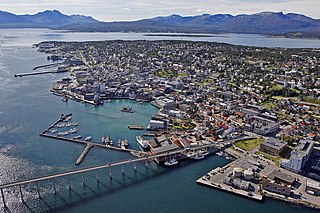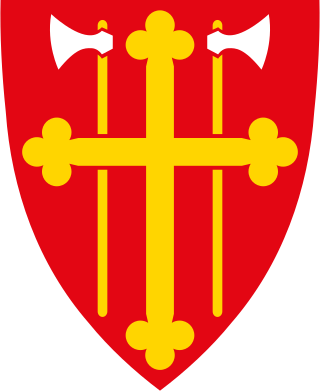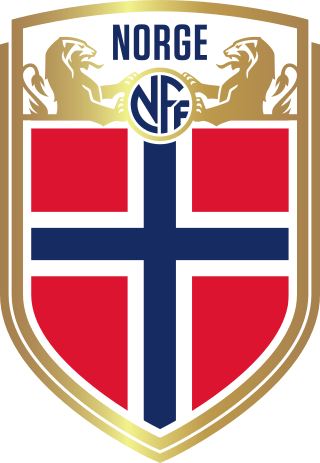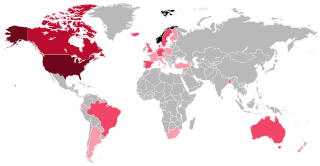Related Research Articles

The Kalmar Union was a personal union in Scandinavia, agreed at Kalmar in Sweden, that from 1397 to 1523 joined under a single monarch the three kingdoms of Denmark, Sweden, and Norway, together with Norway's overseas colonies.

Norway, officially the Kingdom of Norway, is a Nordic country in Northern Europe, the mainland territory of which comprises the western and northernmost portion of the Scandinavian Peninsula. The remote Arctic island of Jan Mayen and the archipelago of Svalbard also form part of Norway. Bouvet Island, located in the Subantarctic, is a dependency of Norway; it also lays claims to the Antarctic territories of Peter I Island and Queen Maud Land. The capital and largest city in Norway is Oslo.

Norwegian is a North Germanic language spoken mainly in Norway, where it is an official language. Along with Swedish and Danish, Norwegian forms a dialect continuum of more or less mutually intelligible local and regional varieties; some Norwegian and Swedish dialects, in particular, are very close. These Scandinavian languages, together with Faroese and Icelandic as well as some extinct languages, constitute the North Germanic languages. Faroese and Icelandic are not mutually intelligible with Norwegian in their spoken form because continental Scandinavian has diverged from them. While the two Germanic languages with the greatest numbers of speakers, English and German, have close similarities with Norwegian, neither is mutually intelligible with it. Norwegian is a descendant of Old Norse, the common language of the Germanic peoples living in Scandinavia during the Viking Age.

Oslo is the capital and most populous city of Norway. It constitutes both a county and a municipality. The municipality of Oslo had a population of 709,037 in 2022, while the city's greater urban area had a population of 1,064,235 in 2022, and the metropolitan area had an estimated population of 1,546,706 in 2021.

Old Norse, Old Nordic, or Old Scandinavian, is a stage of development of North Germanic dialects before their final divergence into separate Nordic languages. Old Norse was spoken by inhabitants of Scandinavia and their overseas settlements and chronologically coincides with the Viking Age, the Christianization of Scandinavia and the consolidation of Scandinavian kingdoms from about the 7th to the 15th centuries.

Scandinavia is a subregion in Northern Europe, with strong historical, cultural, and linguistic ties between its constituent peoples. Scandinavia most commonly refers to Denmark, Norway, and Sweden. In English usage, it can sometimes also refer more narrowly to the Scandinavian Peninsula, or more broadly to all of the Nordic countries, also including Finland, Iceland, and the Faroe Islands.

Svalbard, also known as Spitsbergen, or Spitzbergen, is a Norwegian archipelago in the Arctic Ocean. North of mainland Europe, it lies about midway between the northern coast of Norway and the North Pole. The islands of the group range from 74° to 81° north latitude, and from 10° to 35° east longitude. The largest island is Spitsbergen, followed in size by Nordaustlandet and Edgeøya. The largest settlement is Longyearbyen.

Trondheim, historically Kaupangen, Nidaros and Trondhjem, is a city and municipality in Trøndelag county, Norway. As of 2020, it had a population of 205,332, was the third most populous municipality in Norway, and was the fourth largest urban area. Trondheim lies on the south shore of Trondheim Fjord at the mouth of the River Nidelva. Among the major technology-oriented institutions headquartered in Trondheim are the Norwegian University of Science and Technology (NTNU), the Foundation for Scientific and Industrial Research (SINTEF), and St. Olavs University Hospital.

Bergen, historically Bjørgvin, is a city and municipality in Vestland county on the west coast of Norway. As of 2021, its population is roughly 285,900. Bergen is the second-largest city in Norway. The municipality covers 465 square kilometres (180 sq mi) and is on the peninsula of Bergenshalvøyen. The city centre and northern neighbourhoods are on Byfjorden, 'the city fjord', and the city is surrounded by mountains; Bergen is known as the "city of seven mountains". Many of the extra-municipal suburbs are on islands. Bergen is the administrative centre of Vestland county. The city consists of eight boroughs: Arna, Bergenhus, Fana, Fyllingsdalen, Laksevåg, Ytrebygda, Årstad, and Åsane.

Haakon VII was King of Norway from November 1905 until his death in September 1957.
Nynorsk is one of the two written standards of the Norwegian language, the other being Bokmål. From 12 May 1885, it became the state-sanctioned version of Ivar Aasen's standard Norwegian language parallel to the Dano-Norwegian written language (Riksmål). Nynorsk became the name in 1929, and it is after a series of reforms still a variation which is closer to Landsmål, whereas Bokmål is closer to Riksmål and Danish.

Molde Fotballklubb is a professional football club based in Molde, Norway, that competes in Eliteserien, the top flight of Norwegian football. Founded on 19 June 1911, the club was originally known as International and changed its name to Molde in 1915. Molde are five-time league champions and five-time Norwegian Cup winners, and have finished second in the league a further nine times. Molde is one of only two Norwegian clubs to have participated in the UEFA Champions League.

Tromsø is a municipality in Troms og Finnmark county, Norway. The administrative centre of the municipality is the city of Tromsø.

The Church of Norway is an evangelical Lutheran denomination of Protestant Christianity and by far the largest Christian church in Norway. The church became the state church of Norway around 1020, and was established as a separate church intimately integrated with the state as a result of the Lutheran reformation in Denmark–Norway which broke ties with the Holy See in 1536–1537; the King of Norway was the church's head from 1537 to 2012. Historically the church was one of the main instruments of royal power and official authority, and an important part of the state administration; local government was based on the church's parishes with significant official responsibility held by the parish priest.

The Norway national football team represents Norway in men's international football and is controlled by the Norwegian Football Federation, the governing body for football in Norway. Norway's home ground is Ullevaal Stadion in Oslo and their head coach is Ståle Solbakken. Norway has participated three times in the FIFA World Cup, and once in the UEFA European Championship (2000).

The Human Development Index (HDI) is a statistic composite index of life expectancy, education, and per capita income indicators, which is used to rank countries into four tiers of human development. A country scores a higher level of HDI when the lifespan is higher, the education level is higher, and the gross national income GNI (PPP) per capita is higher. It was developed by Pakistani economist Mahbub ul Haq and was further used to measure a country's development by the United Nations Development Programme (UNDP)'s Human Development Report Office.

Eliteserien is a Norwegian professional league for association football clubs. At the top of the Norwegian football league system, it is the country's primary football competition. Contested by 16 clubs, it operates on a system of promotion and relegation with the Norwegian First Division.

Norwegians are a North Germanic ethnic group and nation native to Norway, where they form the vast majority of the population. They share a common culture and speak the Norwegian language. Norwegians are descended from the Norse of the Early Middle Ages who formed a unified Kingdom of Norway in the 9th century. During the Viking Age, Norwegians and other Norse peoples conquered, settled and ruled parts of the British Isles, the Faroe Islands, Iceland and Greenland. Norwegians are closely related to other North Germanic peoples and descendants of the Norsemen such as Danes, Swedes, Icelanders and the Faroe Islanders, as well as groups such as the Scots whose nation they significantly settled and left a lasting impact in.

The 2011 Norway attacks, referred to in Norway as 22 July or as 22/7, were two domestic terrorist attacks by neo-Nazi Anders Behring Breivik against the government, the civilian population, and a Workers' Youth League (AUF) summer camp, in which 77 people were killed.

Fjotolf Hansen, better known by his birth name Anders Behring Breivik, his initials ABB, and by his pseudonym Andrew Berwick, is a Norwegian far-right domestic terrorist. He is known primarily for committing the 2011 Norway attacks on 22 July 2011, in which he killed eight people by detonating a van bomb at Regjeringskvartalet in Oslo, and then killed 69 participants of a Workers' Youth League (AUF) summer camp, in a mass shooting on the island of Utøya.
References
- ↑ Tvedt, Knut Are; Scott, Ida. "monarker i Norge". In Bolstad, Erik (ed.). Store norske leksikon (in Norwegian). Oslo: Norsk nettleksikon. Retrieved 1 April 2023.